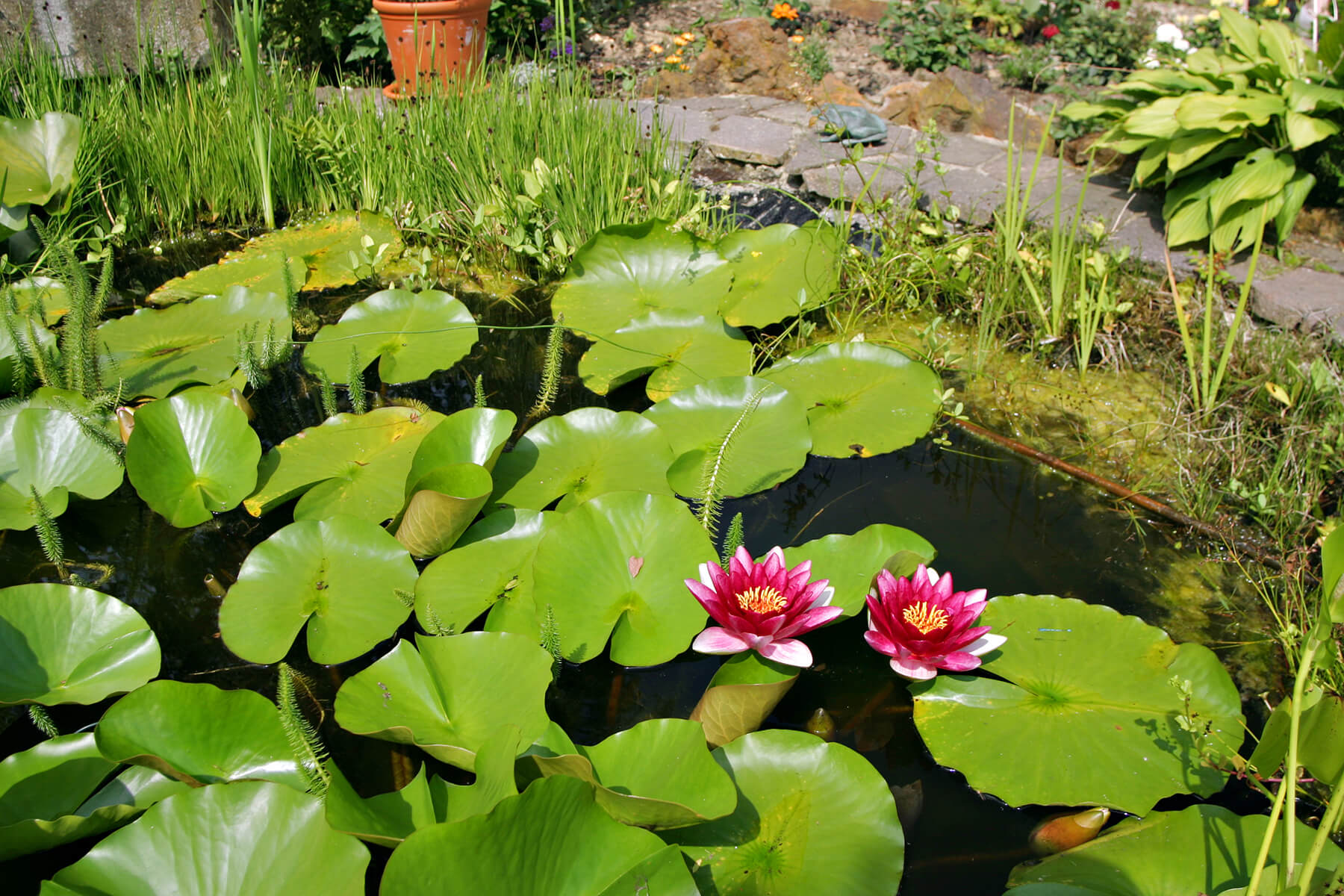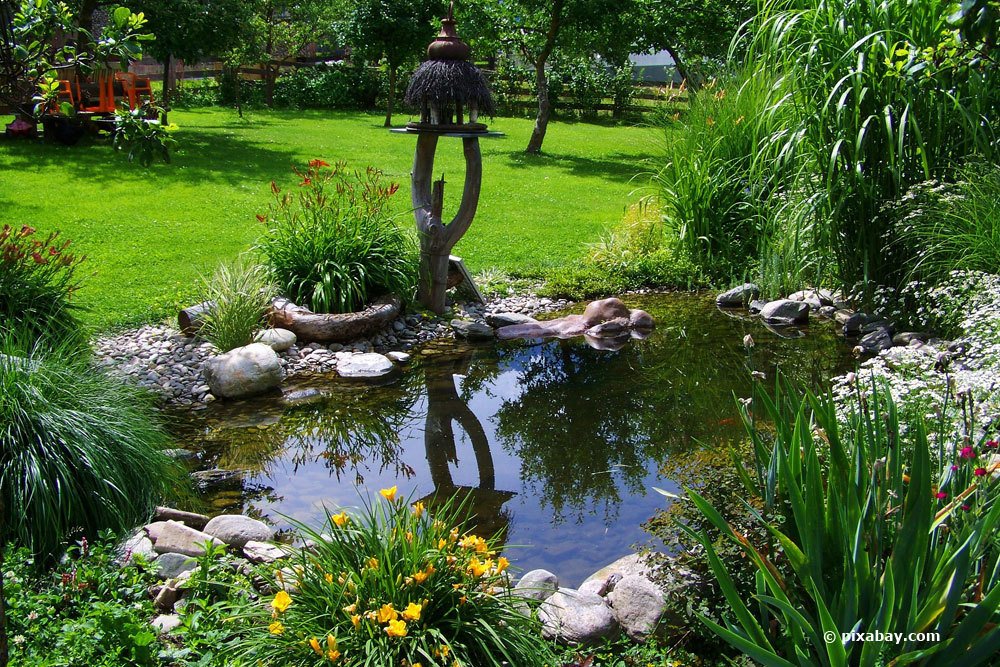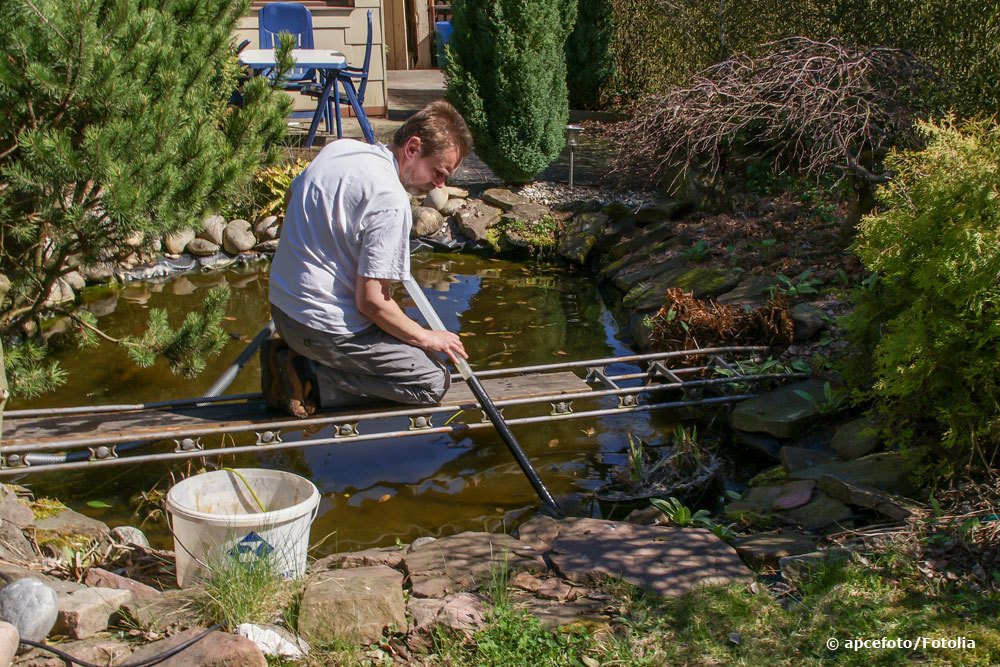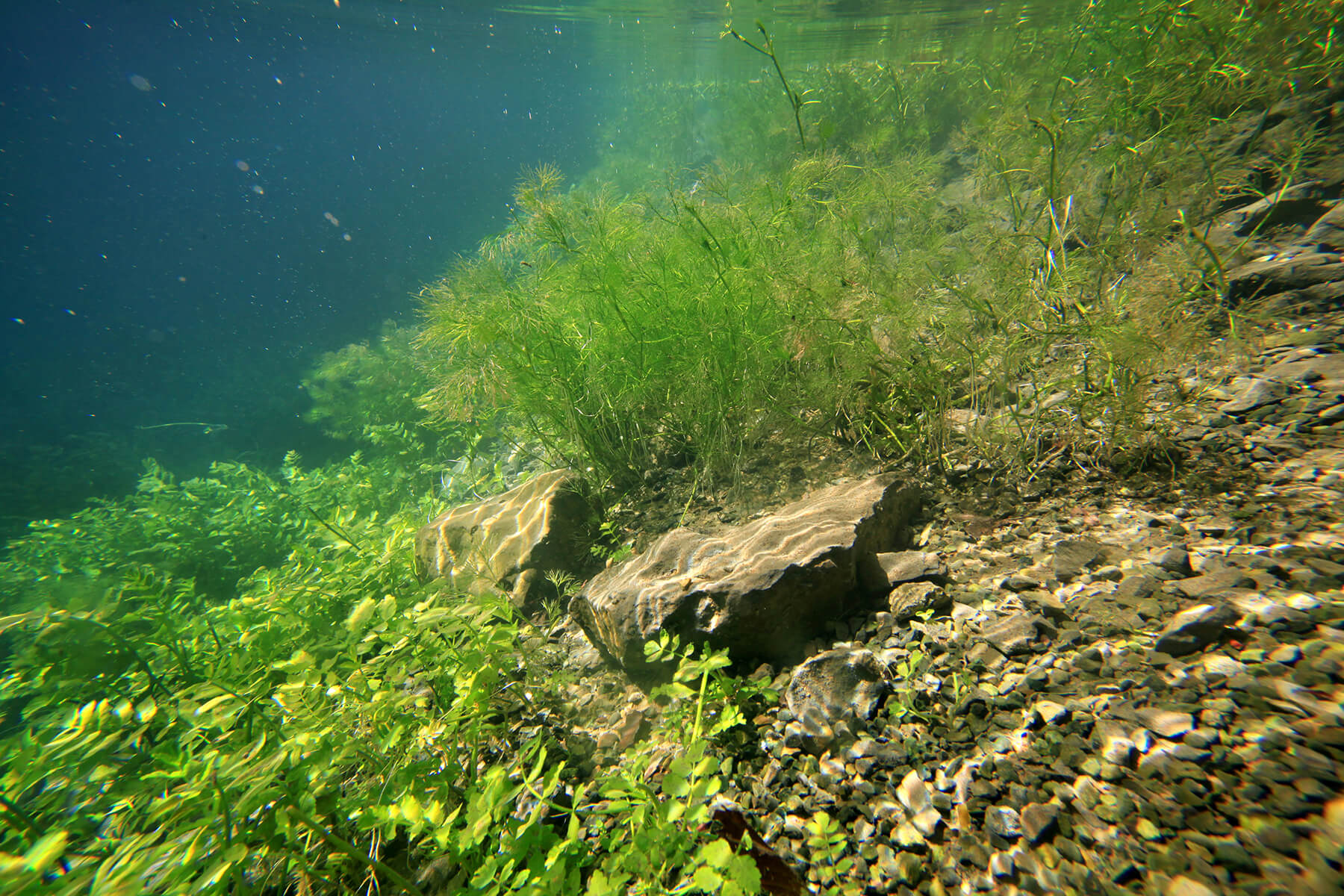Whether hobby gardeners, fish lovers or simply friends of versatile garden design – for many people a garden pond is one of the indispensable elements in the home ornamental garden. Those who are yet to create it will be confronted with the question of the appropriate pond size already during the first steps of planning. We explain required minimum dimensions and dependencies so that your pond will be a complete success.
The question of how deep a garden pond must be reaches us again and again. This is often hotly debated. We would like to try to provide an answer. However, it is not possible to give a general answer.

Contents
- 1 How deep should a pond be?
- 2 Garden pond without fish
- 3 Depth of the pond depending on the type of pond.
- 4 The right pond size
- 5 Planned planting
- 6 Minimum size
- 7 Factors to consider
- 8 Size of the fish
- 9 Use
- 10 Cleaning
- 11 Maintenance and care
- 12 Pond with fish
- 13 Establish depth
- 14 How far could a pond freeze through?
- 15 What role does pond depth play in the warm season?
- 16 Creating a garden pond – depth depends on the type of pond
- 17 Pond depth is also important in summer
- 18 The right garden pond depth for fish
- 19 Author
How deep should a pond be?
The required depth of a garden pond depends on its purpose of use and the region. It is about the sub-zero temperatures in winter, which affect the thickness of a layer of ice on the pond, and the presence of fish in the pond. These still need enough water to survive under a layer of frost. Even plants and microorganisms cannot tolerate a completely frozen pond. But even in summer, a pond that is too shallow can damage the biological balance.
Garden pond without fish
If there are no fish swimming in the pond, its depth depends mainly on the region where it is located. The frost can be of varying severity. The goal is that the pond does not freeze completely. In this case, we would have to remove and store all the plants before winter. If you want to save yourself this work, you need a water depth below the frost line. One meter depth can be enough everywhere, but we should also consider extreme frost. As depth we measure in a pond without fish the distance from the foil on the bottom to the water surface, even if there is still gravel on the foil. It is rare for a pond to freeze to a depth of one meter, but even without fish, the depth should be sufficient so that there is still some water left under the ice for the survival of plants and small creatures.
Depth of the pond depending on the type of pond.
For a garden pond without fish, it is easiest to determine. Depending on the region where the pond is located, we must assume different degrees of frost. If you want to save yourself the work of taking the plants out of the pond every winter and storing them, you should set the water depth well below the frost line.
For garden ponds without fish, the distance from the water surface to the liner counts as the depth. Even if there is gravel or sand on top of it. However, even in a pond without fish, you should plan the depth so that there is still some water under the ice in which the small creatures can survive.
How warm it gets in the summer can also play a role. The greater the surface area in relation to the depth, the faster the water in the pond heats up. This can be counteracted by shady planting and floating plants, but it is better to have at least one third of the pond a little deeper. Also if you want to cultivate pond roses and water lilies you should aim for a water depth of more than 80cm.
How deep a garden pond with fish stocking has to be depends on several other factors. On the one hand, the fish need enough free water under the ice, even if they are in a kind of winter torpor, and on the other hand, the gas exchange must be ensured. In a well-planted garden pond, all the plant parts that reach through the ice provide sufficient gas exchange. In a fish pond without planting in the deeper zones, you have to help a little bit with an ice free holder.
A bubbler or agitated water will also be sufficient to some extent. Ponds with fish stocking should have at least a depth of 1.20 m of free water. In locations where colder winters are expected, at least 1.50 m. This gives the fish enough space even under a thick layer of ice and the amount of water is sufficient to provide enough oxygen for the fish.
As a guideline for the necessary depth of ponds can be noted: Garden pond without fish at least 80 cm, for ponds with fish 120 cm as a lower limit. Empfolene depths for the various types of ponds can be found under pond construction. There, the question: “How deep must a garden pond be?” is explained in more detail for the respective pond type.
The right pond size
For anyone who has already looked beyond the rough goal of a garden pond to its revitalization, it is already clear that there is no one size for the perfect pond. This is because numerous factors influence width and depth, and may also require a certain minimum volume:
Planned planting
- Intended inhabitants in the form of fish, shells, etc.
- Unintended inhabitants expected through natural influx, such as frogs
- Planned use as an ornamental pond or even a swimming pond
- the stability of the biological balance, taking into account the planned filter system
- the desired design or the design dictated by local conditions
- the planned or affordable maintenance effort
Minimum size
Ultimately, there is no real lower limit for pond size. Mini ponds can be as large as a car tire. The other end of the scale, on the other hand, can be several hundred square feet. Therefore, when determining a minimum size, we limit ourselves to perennial ponds in which plants and animals also overwinter. This already results in the first of the following minimum dimensions for a garden pond:
Depth of at least 80 centimeters to prevent freezing through.
Better 1.00 to 1.20m depth to have a buffer for extreme cold periods.
For near-natural revitalization with riparian zone, etc. Width at least 1.00m to maintain sufficient open water area for animals
Area with bank and vegetation zones at least 3 to 5 square meters, below this there is a risk of rapid siltation and insufficient water flow.

Note: The magic limit for ponds is around 3 to 5 square meters. For sizes below that, there are pond shells that make it easy and quick to create including planting terraces. Above that, a pond generally needs to be modeled with pond liner. Prefabricated shells are already available in small sizes, but here individual elements of near-natural ponds are usually omitted in favor of size reduction.
Factors to consider
The biggest influence on a dimensioning deviating from the already mentioned minimum pond size is certainly the vitalization. This means not only plants and fish, but also all the other living creatures that cavort there. With bacteria and microorganisms, this also includes all the living beings that create and maintain the biological balance in the garden pond. Basically, the larger a pond is, the more stable is the ecosystem that develops in it with all its participants. External influences can be absorbed and buffered much more easily by a larger volume. These can be, for example:
- Temperature fluctuations in the pond water
- Changes in the oxygen content
- Input of foreign matter, such as leaves, sand, dirt
- Immigration of animal and plant species, such as algae, insects, frogs, etc.
- Fish and plants
In addition to biological balance, the larger inhabitants, i.e. fish and plants, are the more obvious factors influencing the length, width and depth of the pond. In the case of fish, the garden pond dimension depends largely on the type of animals planned. Because depending on the species, result in different requirements for the water body size based on:
Size of the fish
- Number of specimens to be kept together (schooling fish)
- Swimming behavior
- Other behavioral characteristics, such as escape reflexes or preferences for open water or shore zones
Attention: Often you can find well-known fish species, such as koi or goldfish, in very small ponds. The animals can survive there, but are far from species-appropriate husbandry. However, this should definitely be the goal and can only be implemented if the pond is large enough.
With the plants, some of the aspects are omitted, but you should always keep in mind that even initially small plants grow and take up more space. Especially floating and underwater plants exert a very large influence on the garden pond itself and should definitely be kept in mind when sizing it.
Use
A purely ornamental pond can obviously be much smaller than, for example, a real swimming pond. But even a possible targeted breeding of a certain fish species can already account for a significant increase in space requirements. Therefore, the use of the pond is one of the very first things that should be staked out when sizing it.
Cleaning
In addition to technical filtration systems, today there are also various options for natural purification of the pond water. There are also various mixed forms. Although the size of the garden pond dictates the dimensions of the filter equipment, certain systems are only suitable for certain pond sizes. For example, self-cleaning ability by biological means is only possible above a certain volume, since the stability of the system depends largely on constant water parameters. The stability of the equilibrium therefore plays an essential role. If a pond owner attaches importance to the use of a certain filter technology, this can already result in a certain determination of the size of the pond.
Maintenance and care
Finally, it makes sense to consider not only the creation, the appearance and the life in the pond, but also the effort for maintenance and care. The most beautiful, generously dimensioned pond will not remain intact in the long run if there is no time for its maintenance. Whether it’s fishing out fallen leaves or pruning and cleaning the banks, the larger the garden pond, the greater the effort required. Those who take this point into account during planning will not experience any nasty, recurring surprises later on.

Pond with fish
Fish need more depth to survive, it should be at least 1.00 – 1.20 m. Since ponds are rarely uniformly deep, but usually slope from the edge to the center, the maximum depth is meant in the middle. To the depth, of course, the size of the pond must be put in relation. Ideally, it should have a surface area of at least 15 m², which is the only way to establish a biological balance. These specifications apply to ponds in which at best a few goldfish swim. If you want to keep koi, you need a water depth of at least 1.50 m and a water volume of at least 4,000 liters.
Establish depth
If you purchase a garden in which the pond is already present lined with foil, you will not be able or want to change much about it. Of course, it is always possible to deepen the pond, and even increase its size, but this involves a huge amount of work. You would have to drain the water, remove the liner, dredge the pond and then put in a larger liner. If you are planning a pond, just think about the necessary depth from the outset.

How far could a pond freeze through?
There are winters in Central Europe when the ground freezes through to a depth of 60 cm. This depends on the frost degrees, the duration of the frost days and the sunlight on the affected area. At least as deep then freezes through the water in the pond. We cannot compare the water in the garden pond with the flowing waters or larger lakes, these do not form such thick ice so quickly. Water in the garden pond, on the other hand, does freeze through quite deeply. Since the pond almost always tapers downward, so the volume of water decreases with increasing depth, the frozen pond lacks liquid water, which results in a lack of oxygen. This could cause fish to suffocate. They exhale carbon dioxide themselves, the concentration of which then increases too much, making it act like a narcotic. A blanket of snow on the ice is particularly precarious, blocking sunlight and thus cutting off oxygen production by plants. Instead, the process of oxygen production is reversed. Plants take up oxygen from the water and convert it to carbon dioxide. Smart gardeners therefore eliminate snow on the ice.
What role does pond depth play in the warm season?
In a warm summer, a large but shallow pond heats up too much. Planting around the edges and floating plants usually do not create enough shade to prevent this effect. Therefore, the pond depth of one meter is useful for biological balance even in summer. In any case, it should not be less than 80 cm.
A garden pond is the dream of many garden owners. If this dream is to be realized, the first thing to do is planning. How big should the pond be, and above all, how deep must it be? The answer to this question is not so simple, because there are no general dimensions that are suitable for every pond.
Creating a garden pond – depth depends on the type of pond
The simplest variant of a garden pond is a pond without fish. Such a pond is quite simple to create. It is necessary to take into account the region where you are, and the frost, which is very likely to occur. If the pond is not deep enough, the plants will have to be removed from it every year to overwinter in the basement or shed. This, of course, involves some effort. If you want to save yourself this work, you should plan your pond so deep that the water depth is below the frost line. This frost line is different in every region. It can be assumed that the necessary depth in the foothills of the Alps will certainly be deeper than in North Rhine-Westphalia.
The possibility of an extreme winter should still be factored into the planning. If there will be no fish living in the pond, the distance from the surface of the water to the pond liner is considered the depth. Gravel on the bottom does not change this. Even if in this case you do not have to pay attention to the survival of fish it is still useful to plan the depth of the pond so that the ice does not reach all the way to the bottom in winter. If some water remains under the ice layer, small creatures can also survive.
Pond depth is also important in summer
The depth of the pond not only plays a role in winter, but is also an important factor in summer. . Anyone who wants to create a pond should also note that the greater the surface area of the pond to the depth, the faster the pond heats up in the summer. Therefore, it is advisable to provide at least one-third of the entire pond with sufficient depth. You are a friend of water lilies and pond roses, and can not imagine a garden pond without these plants? Then the pond should have a water depth of at least 80 cm, so that these plants can thrive. Generally speaking, larger ponds are always subject to smaller temperature fluctuations. The ecological balance is better, the larger and, of course, deeper the pond.
The right garden pond depth for fish
Fish can be found in many ponds. If fish are to live in the pond, it is important to ensure sufficient depth when creating the pond. In winter, the fish fall into the so-called hibernation. In order to survive then, they need sufficient water below the ice surface. But this is not the only factor that must be considered, gas exchange is also very important for the animals. In a garden pond with plants, these ensure that gas exchange takes place when they also reach through the ice. If there are no water plants in the deeper zones, an ice free holder should be used. If you also want to give a few fish a home in your pond, the pond should have a depth of at least 1.20 meters of free water. If you live in a region known for colder winters, better plan for 1.50 meters. Even if the ice does get a little thicker, the fish will have plenty of room and enough water to keep them oxygenated.
Although there are no blanket guidelines when it comes to the size and depth of a pond, there are a few recommendations:

